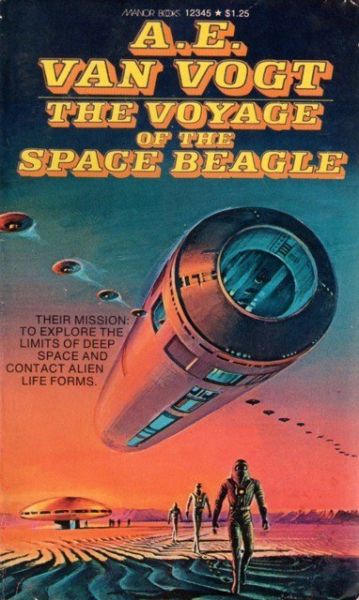Fall Into The Sky
The Voyage of the Space Beagle
By A. E. Van Vogt

2 Jun, 2019
A. E. Van Vogt’s 1950 The Voyage of the Space Beagle is a fix-up novel of deep-space exploration.
All but one person crewing the Space Beagle are experts, knowledgeable in their own field and ignorant of any other. The one exception is the Nexialist, Dr. Elliott Grosvenor. He is a generalist who can synthesize multiple fields. Nexialism is a new field with new methods. The experts on the Space Beagle view the new field with disdain.
Pity, as only Grosvenor can prevent the utter destruction of the mission.
The galaxy and realms beyond are filled with a myriad planets. The Space Beagle crew has a remarkable talent for exploring regions populated by beings who want to eat or otherwise harm the crew. In order of encounter, they meet:
-
Coeurl, a cat-like alien trapped on a barren world short of food. Happily for the alien, the Space Beagle is rich in food-stuffs. Unhappily for the crew, they are the food.
-
The Riin, birdlike aliens whose telepathic touch sends the ship into a frenzy of violence.
-
Ixtl, a relic of an ancient era whose interest in humans lays solely in their potential to be hosts to its eggs and so bring its race back from extinction.
-
Anabis, a vast, voracious being spanning the whole of a galaxy. For Anabis, the Space Beagle is a means to reach new galaxies, that is, new feeding grounds.
In each case Grosvenor’s insight, often supported by archaeologist Korita’s understanding of historical cycles, saves the crew. Most of the crew. The survivors show a remarkable reluctance to learn from experience. In the end, Grosvenor is forced to seize control of the ship!
~oOo~
Is the Space Beagle just unlucky? Or is space jam-packed with entities eager to exploit and harm humans? I am inclined to think the ship unlucky, because this is not the first expedition of its kind. Humans don’t seem to see aliens as serious threats, as they would if previous expeditions had such dire experiences. Of course, most ships don’t have Nexialists, so maybe those crews were consumed and unable to report back.
It’s a good thing that the Space Beagle has a large crew, some thousand plus. Crew are dying like flies and there’s no way they can be replaced.
One would expect that the high death rate would have some effect on the remaining crew. Extended mourning, rage, PTSD. Nothing like that. Nobody on the ship seems to like anyone else all that much. It’s like Star Trek in that sense: redshirts die by the gross but no one seems especially concerned1. Perhaps this is because by and large the crew seem to be an unlikable lot, almost as though HQ chose people who would not be much missed if they failed to return home.
Do not read Van Vogt for the hard science (present only in homeopathic quantities).What science there is seems to be a now-antiquated version of anthropology and history: culture evolves in a predictable progression, history goes through cycles. Grosvenor and Korita work out what stage an alien culture had reached2 and then know how to deal with them. By deal I mean kill.
This is notable for being the sole Van Vogt that I have ever been able to reread. I cannot pull a Damon Knight on the late Van Vogt because frankly, I would need to have read and reread far more than a single book to have an informed view on his fiction. What I can say is that generally his prose and plotting styles were rarely to my taste, save for this precursor to Star-Trek-style tales.
The Voyage of the Space Beagle is available here (Amazon), here (Amazon.ca) and here (Chapters-Indigo).
1: Cue Scalzi’s Redshirts, in which the crew do react to the death rate.
2: All history, everywhere, follows the same pattern. The same white colonialist pattern. As the book says:
Huge old India had crumbled before a few thousand Englishmen. Similarly, all the fellah peoples of ancient Earth were taken over with ease, and did not revive until the core of their inflexible attitudes was forever shattered by the dawning realization that there was more to life than they had been taught under their rigid systems.
